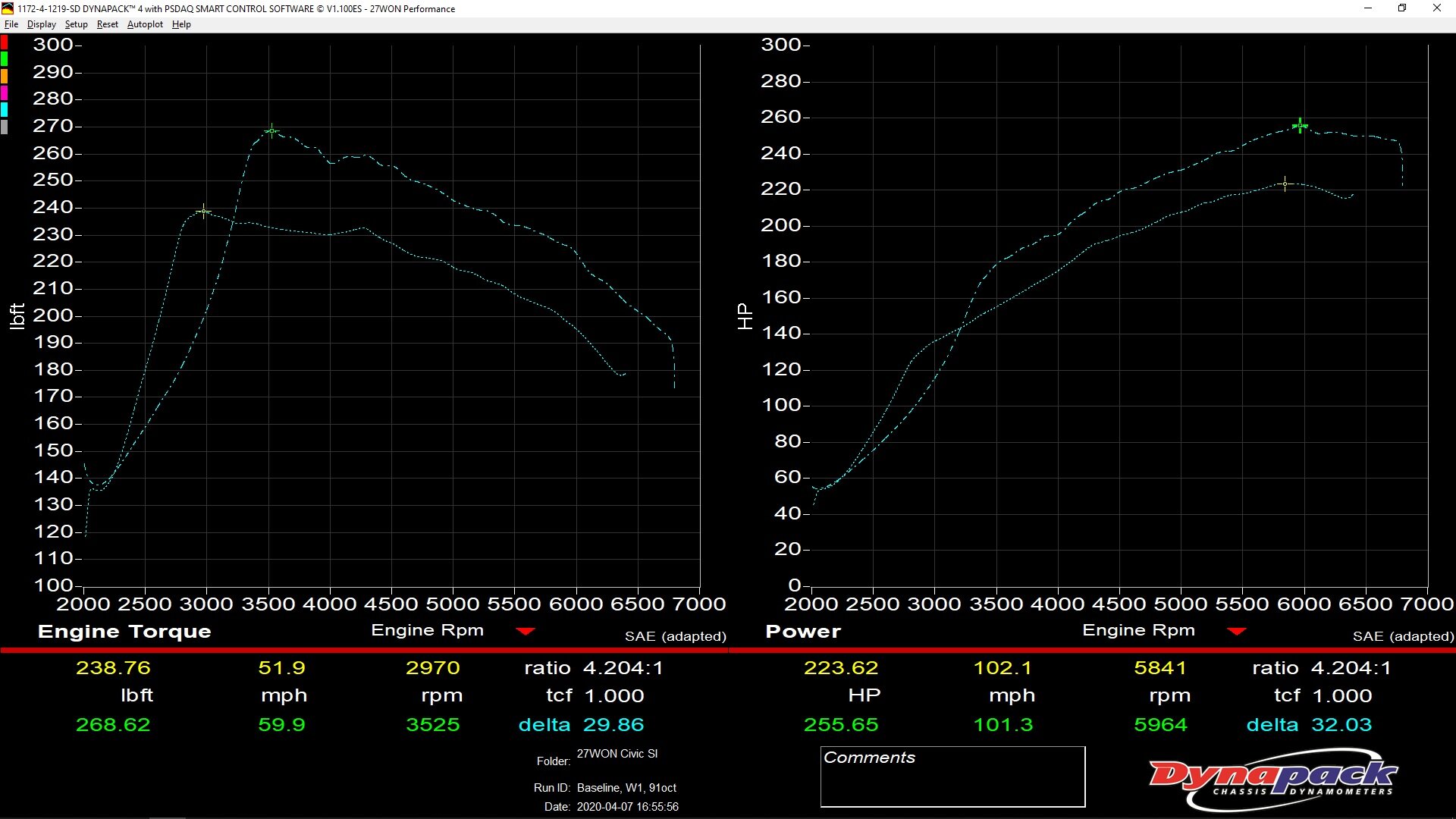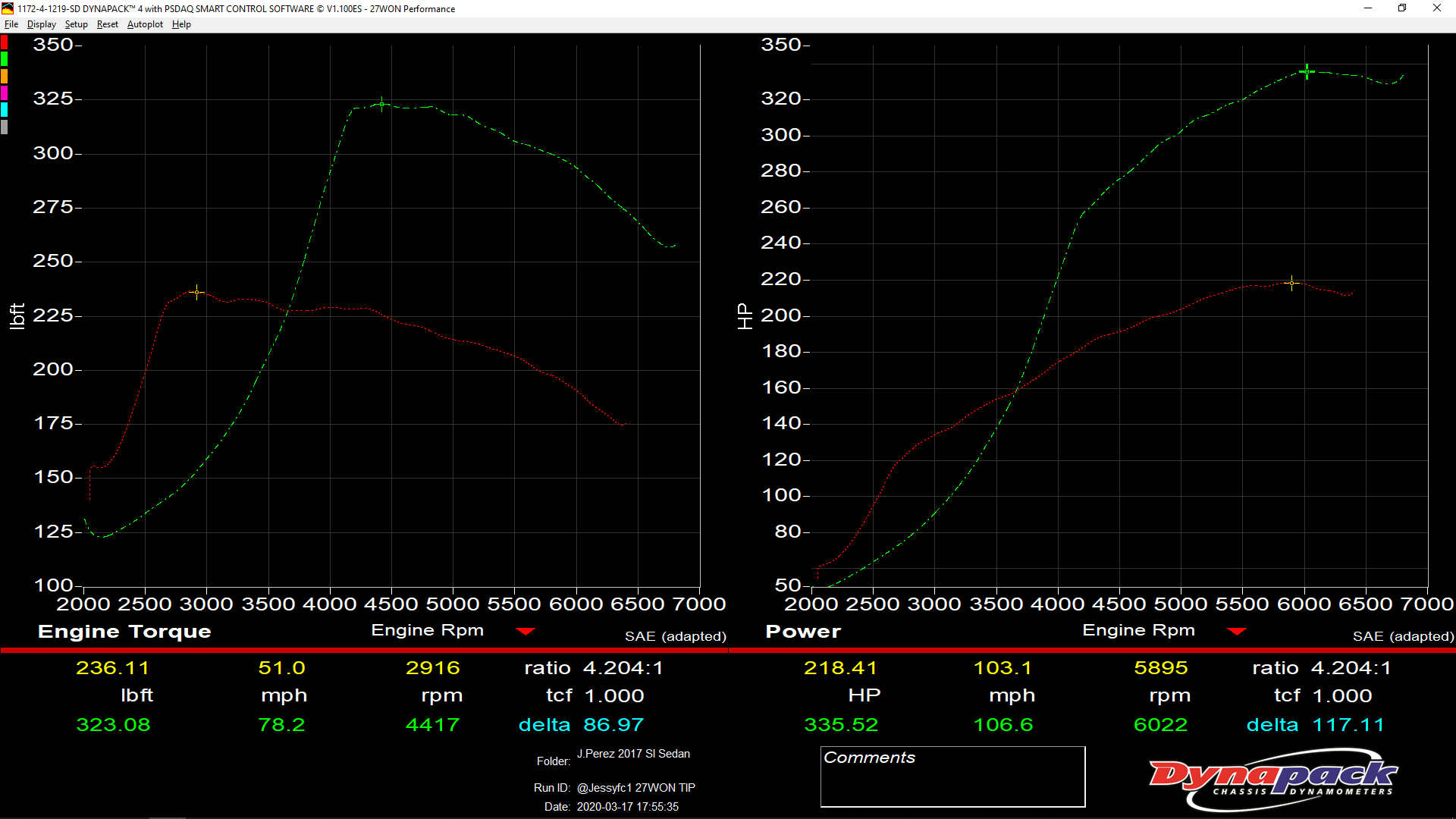W2 Drop-in Turbo Upgrade - Design Pt 5; Power Blog
Here it is; the blog you have all been waiting for. The one that answers the two most asked questions since we announced our W2 turbocharger back in July in Part 1 of this blog series. The two things that most of you only really want to know is:
How much power will it make?
Is it a ball bearing turbo?
The 27WON W2 Drop-in Turbocharger Upgrade for the L15 Earth Dreams Engine
Well, the good news is that this blog will answer these questions. But first, a little disclaimer and background to understand power gains. It’s important to remember that while many like to throw around big numbers, we want to stay focused on the Delta or difference in before and after a part is installed. For example, if Car A makes ~300hp with an “x” part installed and Car B makes ~320hp with “y” part installed then you might be inclined to be all over the 320hp car, But what if Car A was at 260 before and Car B was at 310? Then part Y only netted 10hp while part X netted 40hp. See the difference? Car B looks better on a poster but Car A is making the most of your upgrade.
Alright, let’s get to the first question and elaborate on our power goals for the W2. We know that a W1 turbo can bump up power over the stock turbo on average about 35whp on pump gas and about 70whp with some ethanol. The aim for the W2 was to basically be able to make those W1 ethanol styled numbers on pump gas and then make even more on ethanol than the W1 ever could. In the simplest form, our target was to take what you could make for each fuel type and bump up around 35-45 hp each segment over the W1. This is roughly the power limit that can be safely utilized on a stock engine block.
Test Car - 2018 Honda Civic SI
Upgrades - CAI, Full Turbo-Back Exhaust (TBE), Front Mount Intercooler (FMIC) Kit, Turbo Inlet Pipe, ethanol enabled, 91 oct
Location - Las Vegas, NV ~90deg F ambient temp
Dyno - Dynapack Daq 4
DYNO LOG 1
The log below is the test car with the dotted blue line being a stock turbo and the dashed blue line being a W1 turbo with no other changes.
Dotted Blue Stock Turbo vs Dashed Blue W1 Drop in turbo, no other changes
We are using this log as a frame of reference to show you the differences and gains. You can see on the right graphs that the OEM turbo averaged around 223hp compared to the W1’s 256hp which is an increase of ~35whp. You can see on the left graph that we averaged an increase in 30 lbft of torque.
DYNO LOG 2
Fast forward a turbo swap and we have the same car back on the dyno. We run it again to get more baseline data with an optimized tune for the W1. Then we swap in the W2 turbo and a tune. Results are below;
Blue Line is W1 91 Oct tune, Magenta Line is W2 91 Oct Tune
This is a great graph to visualize what changing the A/R of a turbine housing can do. The dotted blue line is the W1 and the dashed magenta line is the W2. You can see that the W2, being larger, is slower to spool and hit peak torque. You can see that it carries more torque and HP everywhere after ~4200rpm. This is a direct impact from changing the A/R from .50 to .65. It's a bigger area so it takes longer to “fill” the scroll but it will move more air once filled.
We netted max 42whp and 19wtq over a W1 thus hitting our goal of a 35-45whp increase on 91oct fuel. We believe we can make more torque lower in the powerband but since we are still on a stock block we opted to stay conservative and not hit the lower region of the curve has hard.
DYNO LOG 3
The next graph is the same car but this time the W2 is tuned and running an ~35% ethanol blend of fuel.
Blue is W1 91oct, Orange is W2 Ethanol mix
In this case, the dotted orange line is the W1 making 258 whp on 91 oct and the dotted is the W2 making 347whp on ethanol. We netted an average of over 40whp and 30 feet pound of torque when adding in flex-fuel. You can also see that with ethanol and a custom tune we were able to bring the torque curves very close to each other. With some custom tuning and the right fuel, you can nearly mimic W1’s low-end response and really pick up some gains on the top end.
We again opted to stay conservative in the area below 3500 rpm to keep our stock block safe. If we did have a built engine we could be more aggressive here and get the unit to spool quicker since we would have the rods and pistons that could take the extra stress.
DYNO LOG 4
Stock Turbo Red line vs W2 turbo Green line
For this last graph, we compare a stock turbo with the W2 turbo on Ethanol so you can see just how big the W2 is. We did this on a local customers 2018 Civic SI with the standard array of bolts on as well. This was done to give you all another vehicle case to look at. The red line is the stock turbo and the green line is the W2 turbo. Over 117 whp and 86 ft lb of torque!
The W2 takes the performance of your Honda Civic to the next level and really allows you to play with the big boys. As mentioned this was all done on stock blocks. We are pretty confident we can get more tq and hp out of a built bottom block but as mentioned we played it safe to preserve our stock engine. This is a turbo that will grow with you.
Now to wrap it all up - what about the bearing? The testing performed above was all completed with a journal bearing version of the W2 turbocharger. The journal bearing version will launch by the end of the year. The team is currently validating a ball bearing version and we aim to offer that as a more expensive option in early to mid-2021. We expect to see a small increase in spool and power with the BB W2 along with added durability.
All this testing was completed on a stock blocks with ~30k miles respectively. A built block will handle more abuse and then we can get more from the W2. We will be doing an engine build in the not too distant future. So be sure and follow along with us on that journey.
On a closing note, remember net gains and the power curve. From a stock turbo to a W1 on 91 Octane gas you can expect around +40hp. Bump that up to a W2 and you can double that to about +80 hp. Throw in some corn juice and you are likely over +120hp. Not bad for a little 1.5L!
Stay tuned for the release of the W2 in the next few months.
REDEFINE the Aftermarket
-Vincent






